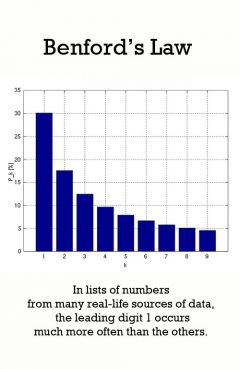Benford's Law

Release Date: //1938
Country of Release:
Length:
MPAA:
Medium: Paradox
Genre:
Release Message: In lists of numbers from many real-life sources of data, the leading digit 1 occurs much more often than the others. Authored by Frank Albert Benford, Jr.
Description: Benford's Law, also called the First-Digit Law, refers to the frequency distribution of digits in many (but not all) real-life sources of data. In this distribution, 1 occurs as the leading digit about 30% of the time, while larger digits occur in that position less frequently: 9 as the first digit less than 5% of the time. Benford's Law also concerns the expected distribution for digits beyond the first, which approach a uniform distribution. This result has been found to apply to a wide variety of data sets, including electricity bills, street addresses, stock prices, population numbers, death rates, lengths of rivers, physical and mathematical constants, and processes described by power laws (which are very common in nature). It tends to be most accurate when values are distributed across multiple orders of magnitude. The graph here shows Benford's Law for base 10. There is a generalization of the law to numbers expressed in other bases (for example, base 16), and also a generalization from leading 1 digit to leading n digits. It is named after physicist Frank Benford, who stated it in 1938,[1] although it had been previously stated by Simon Newcomb in 1881.